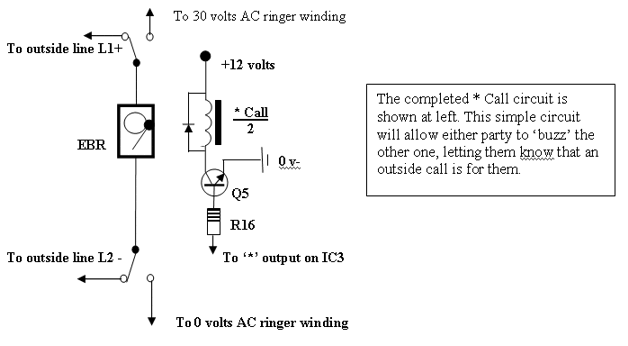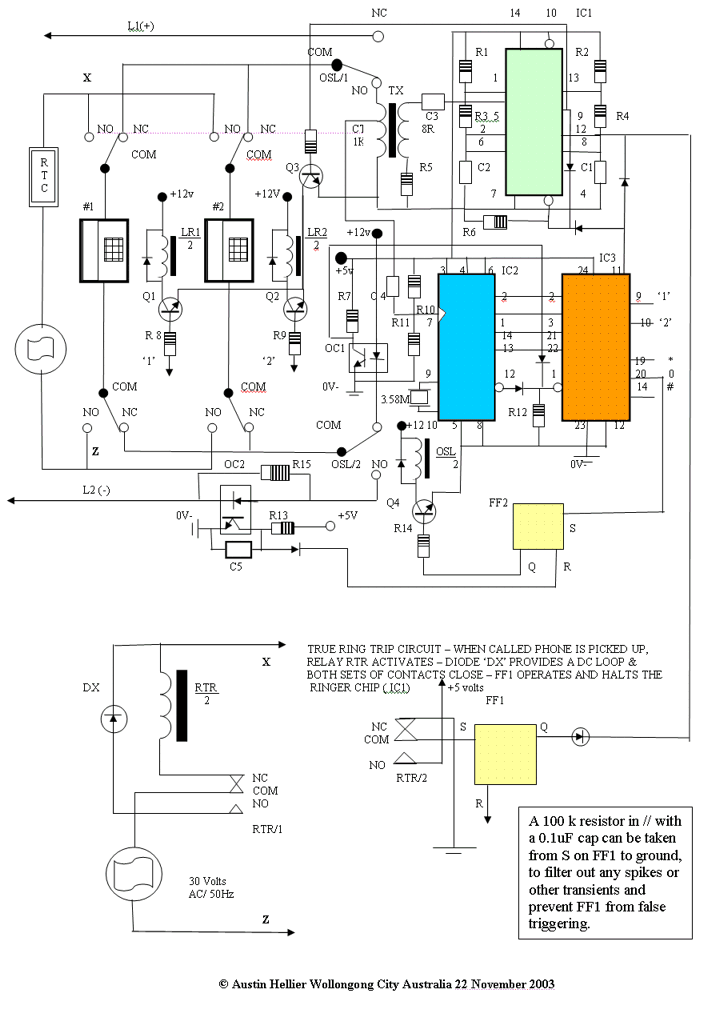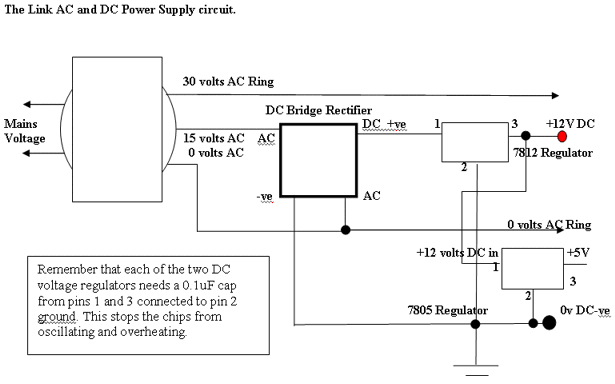The Link A2B+1 (the Link Telephone Intercom - DTMF version)
Author: Austin Hellier, Wollongong City, Australia © 1997-2003
The Link A2B+1 – ExplanationSince the recent publication of ‘The Link Telephone Intercom’ on the net, a number of email requests have come in asking for a DTMF version, with 2 or more phones that can in fact access an outside line. So, back to the ‘drawing board’ (read: PC screen) I went, and what you see above (somewhat more complicated, but nevertheless extremely reliable design) is the result of some ten hours of designing, building and testing not one, but two identical Link circuits. The original DTMF version is now set up between my bed sitter unit at the back of my shop – extension #1, and my elderly next door neighbour, who lives in the unit behind the shop – extension #2. It is proving very handy and although my outside line is not connected to that version at this stage, initial tests proved that both making and receiving calls works perfectly… Important Note: All chips run off a +5 V regulator and all relays and telephone handsets run off a +12 V regulator!!! DO NOT screw this one up – or you’ll be having Kentucky Fried Chips for dinner…
Tone Dialling – At Last!
This version of the Link uses DTMF tones for dialling both internally between handsets, and externally for outside calls. Remember, in some countries, it is ILLEGAL to simply connect unapproved and untested equipment to Telco lines, so avoid the fine and confiscation of your equipment, and ask nicely… OK – now, the link A2B as shown has only 2 handsets, numbered ‘1’ and ‘2’. When the Link is at reset, both phones are ‘on hook’ and no external incoming call is present. If an outside call rings the electronic bell ringer (EBR - not shown, but connected across L1 and L2) then anyone near either of the two phones can answer that call by simply picking up a handset (‘off hook’) and dialling a zero (0) This provides a ‘set’ pulse for FF2 and operates the OSL relay, and places BOTH handsets across the outside Telco line. Remember, both handsets are wired across the inside LINK and so their bells won’t respond to the AC ring current present on the outside line, on an incoming call – that’s why we need the EBR across the line… When you’ve finished the outside call, simply hang up and line optocoupler OC2 will monitor for an open circuit, reset FF2 (after about a one second delay,) and release relay OSL via buffer/driver transistor Q4, returning both phones to the inside Link circuit. . On an internal call, simply pick up your handset and dial either ‘1’ or ‘2’ and then you’ll hear ring tone, and the electronic bells/beeper on the other phone handset will ring at about one second intervals (US style ring cadence). When the called party picks up their handset, the Ring Trip circuit (RTC) will trip, both ring tone and ring current will cease, and you can talk. When you’ve finished, both hang up and the Link will reset itself, ready for the next call.
Link A2B Circuitry A basic DC loop is formed by an off hook handset, the 1K winding of Tx and ground, followed by the +12 v terminal, the led inside OC1 and back to the handset via both normally closed (NC) contacts of LR1. When a phone is taken off hook, the led lights up, turning the phototransistor inside OC1 hard on, and grounding its collector terminal, and thus removing the ‘reset’ pulse via a diode, from the ‘R’ terminal of FF1 and the junction of pin 1/IC3 and the top of R12 via another diode .When a digit (say ‘2’ in this case) is dialled, the DTMF decoder chip (IC2 – MC 45436) will feed the hex coding into the inputs of IC3 (CD4514, a ‘1 of 16’ decoder) and at the same time, pin 12 of IC2 (indicates a valid DTMF tone pair) will provide a momentary high pulse to pin 1 of IC3, strobing it so that its outputs can change appropriately. Pin 10 of IC3 will go high turning on Q2 in unison with pulses from pin 9 of IC1, via driver transistor Q3. This chip is the NE 556 dual timer, set up much the same as in the Link pulse dial version, except that it now puts out a high pitched dial and ring tone. This is because the DTMF decoder ship likes service tones to be around the 350 to 400 hz tone range – low frequency tones seem to send it rather cross eyed…
When the Link is at reset, pin 11 of IC3 is high, holding IC2 from pulsing via a diode to pins 12 and 8, while at the same time enabling the other half of the oscillator (producing the high pitched dial tone) via another diode to pin 4. When a DTMF tone is received, pin 11 of IC3 goes low, removing these two highs, and allowing IC1 to provide ring pulses from pin 9 via Q3 to the called party’s line circuit relay driver transistor (in this case – Q2). This then allows Q2 to pulse the relay on and off in unison with the interrupted ring tone, which also applies interrupted ring current to the called party’s handset, while still in its ‘on hook’state. When the call is answered, the RTR relay operates momentarily. The first set of RTR/1 contacts disconnects the AC ring from one side of the relay and feeds it through diode DX, forming an instant but temporary DC loop. The 2nd set of RTR/2 relay contacts ‘sets’ FF1 and halts the ringer via a diode from the ‘Q’ output, to pins 12 and 8 of IC1 for the duration of that call (see diagram at bottom of page 1 above). When the call is completed, and both parties hang up, the internal DC loop is broken and OC1’s led will turn off, turning the phototransistor off, and allowing its collector to go high again, resetting FF1via a diode, and clearing IC3 with the same reset pulse via another diode to pin 1. Dial tone is restored as pin 11 of IC3 will go high again in the reset state, and the Link A2B is ready for the next call. Sometimes on an outside call, relay OSL will activate too fast and the outside line will ‘hear’ the ‘0’ you just dialled to get the outside line. You can wire a 22uF electro cap across Q4 (+ve to collector and -ve to emitter) to slow down the relay activation time and thus avoid this hassle if you need to. Designing a true Ring Trip circuit that works 100% reliably was the hardest part of the exercise. It’s best to answer a phone call during the ‘ring on’ part of the ring cycle. If you answer it during the ‘ring off’ part then there’s a short delay, and it sounds like a glitch when the RTR relay actually trips the ring. While I could have added a couple of optocouplers to tidy this part up, I think that the simpler the arrangement is for AC currents, the better in CMOS type circuitry...
There we have it folks – another Link from the ‘Downunder’ stable – have fun building it and using it around the home, office, school etc – and – watch out for suspicious characters using eye glasses – they could be Telco inspectors… © Austin Hellier Wollongong City Australia 22 November 2003
A Neat Trick You Can Try – ‘* Call’
With the Link A2B as it is, there’s no provision to transfer incoming calls between handsets. Seeing that they’re both switched to the outside line (due to the simple nature of the relay switching matrix,) this can’t happen without extra relays (could become expensive and complicated). However, there is a way to let the other person know that an incoming call is for them. If you take two 0.1uF capacitors – each wired between the COM (common) terminals of relay OSL – one going to circuit ground and the other one to the input of IC2 (DTMF decoder chip) instead of the centre tap of Tx, then whenever you’re on the outside line, you still have access to the tone decoder. You can wire the EBR (electronic bell ringer) via a set of relay contacts, so that when the relay is at rest, the EBR is across the line. You can then activate the relay (called * Call or *C) by pressing the ‘*’ key on your phone keypad, to momentarily ring the EBR from the 30 volt AC supply inside the Link. Take two wires from the NO (Normally Open) contacts of this extra relay and wire them to either end of the 30 volt AC winding of the ringer transformer. This lets the other extension know that an incoming call is for them, not the person who answered it. To complete the wiring of this extra feature, simply take a wire from pin 19 of IC3 (CD 4514 chip) wire it to a 4.7k resistor and then to an extra driver transistor that will operate the relay *C. When the other person picks up their phone (both phones are now in parallel and on the outside line) you can hang up and the other extension phone will hold up the call until they hang up, and then the Link will reset itself back to the internal Link. Wiring the two caps this way prevents harmful voltages and ring currents from reaching the +5 volt CMOS chips when the OSL relay has both phones wired to the internal Link circuit.

Parts List
R1 10k
R2 4k7
R3 100k
R4 100k
R5 470R
R6 4k7
R7 4k7
R8 4k7
R9 4k7
R10 10k
R11 10k
R12 100k
R13 22k
R14 4k7
R15 4k7 (base of Q3)
C1 22uF
C2 .022uF (change to suit pitch of dial and ring tone)
C3 1uf
C4 0.1uF
C5 10uF
Q1-4 BC547 or equivalent
Diodes use 1N4148 or 1N914
IC1 NE556 dual timer chip
IC2 MC 45436 DTMF decoder
IC3 CD 4515B 1x16 decoder
IC4a/b CD 4013B dual RS flip flop (FF1 and FF2)
Xtal 3.579 Mhz
OC1-2 4N25 or 4N28
Relays 12 volt DC DPDT
POWER SUPPLY PARTS
Mains transformer with secondary winding of 15 – 0 – 15 volts AC
Bridge rectifier PB100 or equivalent (2Amp/400piv minimum)
7805 5 volt positive regulator
7812 12 volt positive regulator
4 x 0.1uF filter caps
1 x 2,200 uF filter cap
Note: It’s best to use the more modern two piece electronic phone handsets that have a good quality electronic ringer installed. Cheap type handsets (usually of the one piece variety) suck too much current, and will cause a downgrade of speech volume during conversations. It’s also best to use the same kind of handset throughout to avoid mismatches and differing current drains, which can cause glitches and background hum.
© Austin Hellier Wollongong City, Australia 25th November, 2003.








